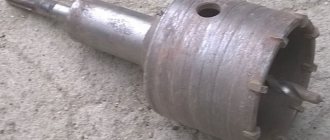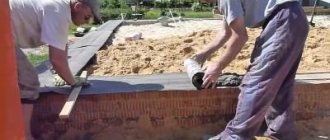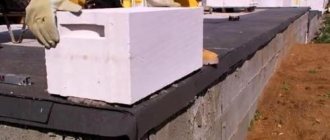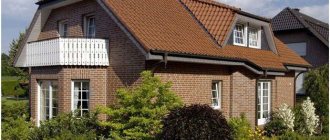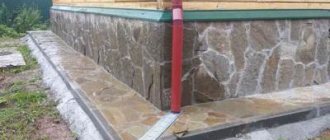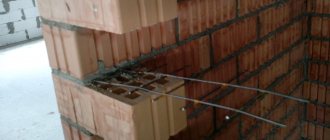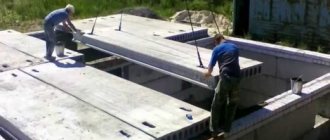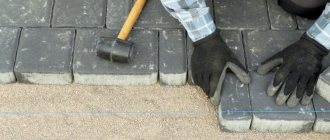When starting a renovation, sometimes it is necessary to demolish part of a wall or dismantle the entire building. The price of demolishing a house depends on several factors:
- size of the building,
- materials from which the house is built,
- Is work at height required?
Breaking a concrete wall is a more complex process that requires the use of specialized equipment. Dismantling internal walls where brickwork, lining or aerated block partitions are used is a simpler task. It must be remembered that dismantling structures is also preparation for this process, which must be carried out by specialists.
| Building dismantling | Unit | Price |
| Building dismantling | m3 | from 250 rubles |
| Dismantling of foam block buildings | m3 | from 450 rubles |
| Dismantling of industrial buildings | m3 | from 200 rubles |
| Hangar dismantling | m2 | from 1000 rubles |
| Dismantling of a military unit, boarding house, sanatorium | m3 | from 150 rubles |
| Dismantling of elevator, farm, barn | m3 | from 150 rubles |
| Dismantling a country house | m2 | from 1500 rubles |
| Dismantling a private house | m2 | from 1500 rubles |
| Dismantling of an apartment building | m3 | from 250 rubles |
| Dismantling the pavilion | m2 | from 1500 rubles |
| Water tower dismantling | PC | from 50,000 rubles |
| Dismantling of metal structures | Unit | Price |
| Dismantling of metal structures, hangars, trusses | ton | from 3000 rubles |
| Metal removal | tons | for free |
| Brick dismantling | Unit | Price |
| Brickwork/house dismantling | m3 | from 250 rubles |
| Dismantling brick partitions | m3 | from 700 rubles |
| Recycling/removal of brick and concrete waste | m3 | from 300 rubles |
| Tree dismantling | Unit | Price |
| Dismantling of floors (wood) | m2 | from 800 rubles |
| Dismantling a wooden house/log house | m2 | from 2000 rubles |
| Dismantling of concrete and reinforced concrete | Unit | Price |
| Reinforced concrete dismantling | m3 | 400-450 rubles |
| Dismantling of floors (precast concrete) | m2 | from 500 rubles |
| Dismantling a monolith floor slab | m3 | from 4000 rubles |
| Dismantling the foundation (monolith tape) | m3 | from 3000 rubles |
| Dismantling the foundation (rubble tape) | m3 | from 2000 rubles |
| Dismantling the foundation (reinforced concrete slab) | m3 | from 7000 rubles |
| Dismantling a reinforced concrete fence | p.m. | from 2000 rubles |
| Dismantling of reinforced concrete walls | m3 | from 4000 rubles |
| Dismantling on site | Unit | Price |
| Pipeline dismantling | m.p. | from 500 rubles |
| Pit development | m3 | from 400 rubles |
| Site layout | m2 | from 100 rubles |
| Tree removal | up to 300 mm | from 5000 rubles |
| Tree removal | up to 500 mm | from 10,000 rubles |
| Dismantling on the road | Unit | Price |
| Dismantling the road slab | m2 | from 200 rubles |
| Dismantling of asphalt and porous concrete | m3 | from 90 rubles |
| Internal dismantling | Unit | Price |
| Internal dismantling of buildings | m2 | from 1000 rubles |
| Dismantling of floor slabs | m2 | from 300 rubles |
| Dismantling of gypsum plasterboard partitions | m2 | from 250 rubles |
| Dismantling glass partitions while preserving | m2 | from 700 rubles |
| Dismantling of chimneys | PC | from 100,000 rubles |
| Removing the ceiling | m2 | from 182 rubles |
| Dismantling of Armstrong/GKL type ceiling | m2 | from 150 rubles |
| Removing tiles (walls) | m2 | from 82 rubles |
| Dismantling of gypsum plasterboard walls (cladding of external and internal walls) | m2 | from 100 rubles |
| Dismantling marble (walls) | m2 | from 164 rubles |
| Removing tiles (floors) | m2 | from 82 rubles |
| Dismantling cement-sand screed thickness 150 mm | m2 | from 500 rubles |
| Dismantling marble | m2 | from 164 rubles |
| Carpet removal | m2 | from 35 rubles |
| Cleaning load-bearing walls from glue and plaster | m2 | from 100 rubles |
| Removing door blocks | PC | 500 rubles |
| Dismantling blinds | PC | 328 rubles |
| Removing stair railings | p.m. | 246 rubles |
| Garbage removal | m3 | from 450 rubles |
General sequence of work
Demolition or dismantling of an object should be carried out in the reverse order of construction, i.e. from top to bottom, by floors, by sections, by spans.
When carrying out demolition work it is necessary:
- ensure the strength and stability of the remaining supporting structures and adjacent elements;
- prevent structures from falling when their fastenings are released (embedding seams, welding, bolts).
To ensure the strength and stability of the remaining structures, the necessary calculations must be performed in connection with the design diagrams of the building changing during the demolition or dismantling process. Based on the calculation results, the remaining structures are temporarily secured. Schemes and designs of temporary fastenings must be given as part of the PPR.
Work on the demolition or dismantling of buildings must be organized using flow methods with the division of objects into sections.
Parts of objects with repeating identical amounts of work are identified as captures. In residential buildings, a part of a floor or a section can be used as an enclosure; in one-story industrial buildings, a span or part of a span within an expansion joint.
General rules of the process
The easiest option to break a concrete wall in an apartment is to use diamond drilling. But not everyone has such equipment or the financial ability to use such services. In everyday life, a concrete hammer is usually used, but working with it will be more difficult and longer, and a large amount of debris will be generated.
If you are interested in the question of how to properly dismantle a concrete wall in an apartment, you should know that such work involves the gradual and partial destruction of the partition. Typically, such structures are built with a gap at the top. During the construction process, this space is filled with soft material, damping tape, tow, plaster or something similar. If so, dismantling should begin with this part. Before starting the process, it is necessary to turn off the power to the electrical wiring, since most likely it runs in the partition. It’s good if the craftsmen know the layout of communications.
Dismantling of residential and public buildings with brick walls
Sequence of work:
- dismantling the roof;
- dismantling the roof fence;
- dismantling wooden structures of pitched roofs;
- dismantling the attic floor;
- floor-by-floor dismantling of external and internal walls;
- floor-by-floor dismantling of interfloor ceilings;
- floor demolition;
- floor-by-floor dismantling of staircases and landings;
- dismantling the ceiling above the basement;
- dismantling basement walls and foundations.
Rules for dismantling industrial frame buildings (single-story and multi-story)
The structural system of industrial buildings of industrial facilities is usually framed from steel or reinforced concrete elements.
According to the structural design, frames can be framed or braced.
In frame frames, stability and geometric immutability in the transverse direction is ensured by frames, in the longitudinal direction - by installing steel connections between columns in one step along each row of columns. The connections are usually established in the middle of the temperature block.
Combining two transverse frames into one block using a floor disk and column ties creates a rigid bonded block that provides spatial rigidity and stability.
In braced frames, the stability and geometric immutability of buildings is ensured by the floor disk (covering) and the installation of stiffening diaphragms between columns in both directions or stiffening cores.
The walls of staircases can also serve as diaphragms or stiffening cores.
The demolition or dismantling of buildings must be carried out in such a way that a spatially stable section always remains during the dismantling process. Therefore, dismantling of building structures should begin in the direction from the ends of the building and the expansion joint to the bonding blocks or stiffening cores on both sides. If necessary, provision is made for the installation of temporary elements that provide the necessary stability. The structures of the connection blocks are disassembled last.
Dismantling of structures of multi-storey buildings is carried out layer by layer, (floor by floor), element by element. Work on the next tier is permitted only after complete completion of work on the previous tier.
Section I. GENERAL DATA
The diagrams are made for dismantling the T1 production housing in axes 1-7¸JN.
The dismantled section of the production building is a one-story frame building measuring 36´24 m in plan, and 10.8 m high inside the building.
The frame of the building is made of reinforced concrete structures: columns 10.8 m high with a cross-section of 800´400 mm are located at intervals of 12´18 m; the trusses have a span of 18 m and a height of 3 m; ribbed covering slabs, of two standard sizes: 12´3 m and 12´1.5 m.
Enclosing structures - wall panels (height - 1.0; 1.2; 1.8 m) 6 m long and 300 mm thick. The half-timbered columns are reinforced concrete, with a cross-section of 300´400 mm. In axes 7¸J-M the wall section is thick. 250 mm to elev. 6.6 m made of sand-lime brick.
Between the columns in the longitudinal direction at around 8.0 m there are horizontal connections representing a rigid spatial metal structure. In axes 1, 4, 7¸JL there are vertical connections, which represent a rigid spatial metal structure.
Inside the housing at elevation. Metal beams of the overhead crane tracks are located 7.2 m along the reinforced concrete columns in the longitudinal direction.
The dismantled section of the T1 body is adjacent to the T2 body from the side of the 7¸M-N axis, and from the side of the 7¸J-N axis to the body to be dismantled.
To carry out work on dismantling frame elements, it is planned to use a RDK-250 crawler crane (boom - 25.3 m; rigid jib - 5 m) as a lifting mechanism, and AGP-18.04 aerial platforms as scaffolding equipment. It is allowed to use other mechanisms with similar load-height characteristics.
Work on dismantling the T1 production building in axes 1-7 ¸ JN is allowed to begin only after completing the installation of new vertical connections in the T1 building, which are provided for by the project to replace those dismantled.
The dismantled structures are transported from the grips to the on-site storage area by special vehicles (panel trucks, scows).
Dismantling pitched roofs of buildings with brick walls
Before starting work on dismantling the roof, all elements of engineering systems (radio and television antennas, wiring, advertising boards) must be dismantled.
Disassembly is carried out in two stages:
- removal of roofing;
- dismantling the load-bearing elements of the roof.
The most commonly used roofing coverings for pitched roofs can be:
- made of galvanized steel sheets;
- from corrugated chrysotile cement sheets;
- from rolled roofing materials;
- from piece small elements.
The steel roof is disassembled in the following sequence:
- the covering sheets (aprons) are removed near the protruding parts (ventilation pipes and other protruding parts);
- the clamps are separated from the sheathing;
- one of the standing seams opens onto the picture along the entire slope of the roof;
- the recumbent seam connecting the picture to the sheets of the gutter is disconnected;
- The picture is lifted with a crowbar and turned over onto the adjacent row.
The rest of the roof is disassembled in the same sequence. Disassembled paintings are rolled into rolls and immediately lowered down for safety reasons.
Dismantling of a roof made of chrysotile cement sheets begins with the ridge elements, then the ordinary sheets are dismantled in the reverse order of installation, after which the pipes, overhangs, and trays are removed.
Roofing made from rolled materials is dismantled by cutting and tearing off sections of it. Roofs made from piece materials are disassembled element by element in the reverse order of their construction.
The wooden sheathing is disassembled manually element by element using nail pullers and special crowbars.
Wooden rafter structures are dismantled entirely using lifting mechanisms. The structures are rigged and supported by a crane, the fastenings are removed.
The disassembled long elements of layered rafters are stored on the roof supported by external and internal walls and then lowered down using a crane and transferred to the storage area.
Dismantling of roofs of panel and frame buildings
Dismantling the roof is carried out in the following sequence:
- dismantling the roof covering;
- dismantling of parapet panels, cornice blocks and covering slabs.
It is recommended to divide the roofing covering (soft, rolled, mastic, metal sheets) into strips of 1000x500 mm (slabs of 1000x1000 mm) that are convenient for carrying and storing.
The cemented joints, seams, and metal connections of roofing slabs (flooring) are freed from the mortar. It is recommended to sling roofing slabs using a four-legged sling and four grips, which are installed in specially drilled (punched) holes. Then the crane slightly tightens the slings and cuts the metal connections.
The roofing slab is torn off using a hydraulic wedge or jacks and lifted a few centimeters with a crane. Before lifting, the roofing slab is raised 20-30 cm to check the reliability of the sling. In the same way, parapet panels, cornice blocks and house covering slabs are dismantled.
Floor-by-floor dismantling of precast concrete slabs and wall panels
Before dismantling the slabs, the following work is performed:
- in places of slinging, holes with a diameter of 40-60 mm are drilled;
- joints and seams between slabs are freed from embedment concrete using the methods specified in the technological map.
After this, the slabs are slung with ring slings, torn off by wedging with hydraulic wedges or jacks from the supporting plane, and after checking the reliability of the insurance, they are lifted and transferred to the storage area.
Dismantling of external and internal walls of panel buildings is carried out in the following sequence:
- the panels are temporarily secured to the grip using struts,
- two holes are drilled in the panels for slinging, into which anchors are inserted;
- slinging of panels is carried out using a four-legged sling;
- the filling of the vertical seams at the ends of the panel is cut out or knocked out, the mounting connections are cut off, and the struts are removed;
- when the slings are tense, the panel is torn off using metal wedges driven into the seam between the panels, hydraulic wedges or jacks;
- the panel is raised 0.5 m to be lifted from the supporting surface, as well as to check the sling, and is moved to the warehouse.
Dismantling of the internal panels is carried out in the same sequence as the external ones. The disassembled panels are installed in pyramids in the warehouse.
Dismantling of panel walls of multi-storey industrial buildings is carried out from top to bottom, floor by floor. Slinging is done using a four-leg sling and grips inserted into drilled holes. The joints between the panels are freed from the mortar, the details of the connection between the wall panels and the columns are cut off. The panels are dismantled and transferred to the warehouse.
What walls can be dismantled
Dismantling of concrete partitions is possible if they are not load-bearing. Floors rest on walls with special abilities, so if they are damaged, the building may even collapse. You can find out which structures cannot be touched by their location. They are usually perpendicular to the floor beams.
Dismantling brick walls of buildings
Methods for dismantling brick walls of buildings are prescribed depending on their thickness, the strength of the mortar joints and the conditions of dismantling. When laying the walls of ancient buildings using lime mortar, dismantling is carried out along the planes of individual bricks.
When dismantled, brick walls of buildings built with cement-sand mortar are cut into separate blocks or broken into blocks. The dimensions of the blocks, depending on the strength of the masonry and the load-carrying capacity of the mechanisms, are assigned in the PPR.
Slinging of brick blocks is carried out using grab grips, as well as using pins inserted into drilled holes and grips. Disassembly is carried out using hand-held machines and a variety of hand tools (jackhammers, disc milling machines, crowbars, sledgehammers, etc.) in accordance with GOST 12.2.010, GOST 12.2.013.0. With strong masonry, to improve the conditions for disassembly, cuts and hems are made to the walls.
Brick blocks are moved downwards by cranes, freight elevators or using closed chutes, and transported to the elevator (chute) by wheelbarrows.
Dismantling of brick walls is carried out from scaffolding or inventory scaffolding.
What is a screed and its types
A concrete screed is a layer of concrete that is stretched over the surface of the entire room and can have a thickness of three centimeters.
It is made from various materials, with or without additional mineral fillers. There are three main types of concrete floors:
- Self-leveling self-leveling coating.
- Cement-sand coating.
- Concrete screed with a topping layer.
Each of them has different characteristics and properties and, accordingly, dismantling the floor screed will occur slightly differently.
Dismantling of structural elements of multi-storey precast concrete frame buildings
Before dismantling the crossbar, the column is braced with struts. Dismantling is carried out in the following sequence:
- the joints of the crossbar with the column are freed from concrete coating,
- the connecting steel parts and welds on the column console are cut off - after slinging the crossbar and loosely tensioning the slings;
- using a hydrocline, the crossbar is separated from the horizontal platform of the column console.
The crossbar is dismantled and transferred to the storage area. After dismantling the crossbar, the column is dismantled, the work is performed in the following sequence:
- columns are slinged;
- if the tension of the slings is weak, the temporary fastenings of the columns (struts) are removed;
- the joint of two columns is freed from embedding concrete;
- steel connecting elements are cut;
- using a hydrocline, the column is raised and moved slightly;
- the upper column is torn off;
- the dismantled column moves to the storage location.
↑ Modern technologies are the best assistants when carrying out repairs.
More modern technologies are diamond cutting and drilling. A special tool for achieving this goal does not create much noise and can easily cope with individual fragments of concrete screed. The diamond cutting method avoids severe damage and the formation of large amounts of dust.
- Diamond tools are designed for dismantling reinforced concrete floors. For its uninterrupted operation, a source of electricity and a constant water supply are required. A source of water is necessary to cool equipment and reduce dust concentrations in the premises.
- Removing floors by cutting or drilling is quite convenient in densely populated urban homes. Despite the fact that the technology is expensive, it allows you to completely solve the problem of leveling floors.
- Floors with pieces of iron reinforcement are removed using a seam cutter. The seam cutter works on the principle of cutting expansion joints on the surface of a concrete floor. The equipment is high-tech and cuts concrete without a huge amount of time and effort on the part of the worker. The seam cutter dismantles both individual fragments of the screed and the entire structure.
Dismantling of load-bearing structures of one-story frame buildings
Rafter (sub-rafter) trusses (steel or reinforced concrete), when dismantling the load-bearing and enclosing structures of the covering, are secured using braces or struts to ensure the stability of the system.
Trusses are dismantled in the following sequence:
- the truss is slinged (the slinging location is indicated in the PPR);
- when the sling tension is weak, the bolts and welds on the columns are cut off;
- the trusses are raised 0.5 m above the installation site;
- the farm is transferred to the vehicle.
Transportation of farms is carried out in accordance with the requirements for transportation of new products.
Dismantling of columns of multi-storey industrial buildings (steel and reinforced concrete) is carried out in the following sequence:
- the column, after dismantling the trusses, if required according to the calculation results, is braced for stability by two braces in the plane of least rigidity;
- after slinging the column, the concreting of the base of the columns is broken down and the anchor foundation bolts are cut off (for steel columns), temporary connections are removed;
- a reinforced concrete column, rigidly clamped in the foundation, is cut down, with a weak tension on the slings, the exposed reinforcement of the columns is cut off, and the remaining concrete is knocked out;
- the column rises 0.5 m above the installation site and is transferred to a temporary storage warehouse.
Columns should be stacked with wooden spacers - according to the rules for storing new columns.
Dismantling of crane beams is carried out in the following sequence:
- crane beams are slinged, the slinging locations are indicated in the PPR;
- when the tension of the slings is weak, the steel connecting parts of the beam with the column are cut off, and the anchor bolts are cut off;
- the beam, using a hydraulic wedge or jack, is torn off from the supporting plane and raised above the installation site by 0.5 m;
- the beam is transferred to the vehicle.
Dismantling of steel crane beams 12 m long is carried out in enlarged sections, including crane rails, braking devices and stops;
Dismantling of foundation beams is carried out in the following sequence:
- the blind area is dismantled and soil is excavated to the depth of the foundation using an excavator;
- the embedment concrete between the beams is removed using jackhammers;
- the beam is torn off from the supporting plane using a hydraulic wedge or a jack;
- the beam is raised by 0.5 m and transferred to a temporary storage warehouse or vehicle.
Enclosing structures and columns. Dismantling of external wall panels is carried out completely in sections downward or partially by removing a row of panels adjacent to the roof. First, using jackhammers, the monolithic seam is broken along the contour of the panel. Then it is slung using a device that includes two brackets with fixing fingers (Fig. 9.6). The cutting of the embedded parts securing the panel to the columns is carried out using a gas cutting machine. At this time, the panel being dismantled must be held in place by a crane and braces. The freed panel is placed on a vehicle parked within the crane’s operating area for subsequent removal.
Dismantling of wall panels of multi-storey buildings should be carried out alternately on each floor, including using a self-propelled jib crane, which dismantles the covering slabs. Workers are accommodated in hanging cradles, periodically rearranged around the perimeter of the building. Replacement of columns inside the workshop is carried out with preliminary hanging of the covering structures, i.e., re-supporting the trusses installed on the head of the dismantled column, on temporary racks they are brought under additionally created support units in the lower chords of the trusses near the main support units.
To replace reinforced concrete columns inside existing industrial buildings, the method of dismantling columns by rotating around a hinge using winches is often used (Fig. 9.7a). With this method, the coating structures are first supported on temporarily arranged supports. After this, oxy-fuel cutting is used to disconnect the supporting units of the trusses from the embedded parts of the removed column. The rotary hinge is secured to the dismantled column, which ensures its stability after the destruction of a section of the column near the foundation. Then two movable pulley blocks are secured to the column: one at the top, the other below the center of gravity of the column. After cutting down the concrete head (at least 600 mm) and the bottom of the column between the rotary joint cages (at least 400 mm) and cutting the load-bearing reinforcement, the column is lowered by turning on the pulley attached to the upper part; another pulley will start working only after the column is tilted 30° to the horizon.
Dismantling of reinforced concrete columns with winches (Fig. 9.7, b) is used in the case when work inside existing workshops is carried out without dismantling the covering structures, and the main frame structures make it possible to secure the used rigging and absorb additional loads that arise when dismantling the column and crane beams.
Replacement of metal columns inside workshops using a support hinge (Fig. 9.8) is carried out in existing workshops with high cramped conditions and the impossibility of access for installation cranes to the work area. The use of a support hinge allows the new column to be lowered and raised in a strictly fixed plane.
The columns are delivered by electric overhead cranes. First, the trusses are strengthened and their support tables are attached to the gussets of the upper chords. Then, using electric winches using blocks mounted on mounting support tables, two temporary tubular supports are installed and secured in the design position. Then they installed jacks with a lifting capacity of 200 tons
they are pushed aside and, after disconnecting the supporting units of the trusses from the column being dismantled, the loads are transferred to each temporary support using jacks until a calculated gap is formed between the supporting part of the truss and the head of the column. Next, the column is disconnected from the foundation and winches are used to rotate it around the hinge and lay it in a horizontal position, and then remove it.
Holes are drilled in the body of the foundation and short smooth anchor bolts are installed using epoxy glue, and then the supporting swivel hinge is installed and secured with anchor bolts. After this, the mounted column is laid on wooden beams and its end is brought into the support hinge cage, where it is rigidly secured after alignment.
Subsequently, the column is rigged and moved to a vertical position using an electric winch and a falling mast. After checking the installation of the column, its design fastening to the foundation is carried out. Then the covering is lowered with jacks and the trusses are secured to the column.
Next, temporary tubular supports are mounted and crane beams are installed, aligning them and securing them according to design.
It is advisable to install intra-shop partitions in cramped conditions using a crane with telescopic tower-boom equipment. This method is used in workshops with a bottom height of trusses up to 15.6 m in places accessible to a crane (Fig. 9.9).
Crane track. Most often, crane tracks (crane beams and crane rails) are replaced due to intense physical and moral wear and tear, the need to install electric bridge cranes with increased lifting capacity, or an increase in the pitch of frame columns.
In places inaccessible to the approach and placement of jib cranes, it is recommended to dismantle the crane beams using electric winches (Fig. 9.10) and pulley hoists.
The work is carried out in the following sequence. First, two cargo winches are installed at the bases of the columns adjacent to the dismantled area and one guy winch is installed in the span. Fixed blocks of cargo pulleys are secured to the column heads, passing fastening ropes around the nodes of the trusses. The dismantled beams are freed from fastenings in the column consoles and welded together along the supporting ribs into a braid. Having secured it at the ends of the beams to be removed, it is lifted by cargo winches by 60-100 mm and then, pulling it away from the support consoles, it is lowered onto the prepared site. The dismantled part is removed by transport.
Small-sized beams are replaced with heavy long-span crane beams when the existing column spacing is increased from 6-12 to 30 m or more. This replacement is carried out using self-propelled jib cranes and, most often, winches and pulleys, the fixed blocks of which are fixed to the supporting structures of the frame. For very heavy crane beams, element-by-element installation is used, installing the beams in parts using horizontal supporting structures.
Crane rails can be replaced with self-propelled jib cranes if their placement inside the existing workshop does not cause much difficulty. If it is impossible to pass and place jib self-propelled cranes, electric winches are used to replace rails if the supporting structures of the frame are capable of supporting additional installation loads.
Lantern structures. Dismantling of lantern structures of one-story industrial buildings is carried out using various means of mechanization, including the use of cable cranes, roof gantry cranes or roof jib cranes.
It is recommended to dismantle the lantern using a cable crane when the length of the workshop is up to 400 m and the weight of the mounted elements is up to 1.5 tons. Roof gantry cranes with a lifting capacity of 1 ton are used when dismantling metal structures of lanterns in the middle spans of reconstructed workshops. In this case, dismantling work can be carried out without stopping production. In combination with a roof crane, a jib crane can be used to remove dismantling elements.
Dismantling of lantern structures when replacing them can be carried out using roof-mounted jib cranes, which reduces the work time. During paired operation of the cranes, the first one performs dismantling work, and the second one performs installation work (see Fig. 9.5).
Coatings. Depending on the specific conditions and nature of the work performed to replace the coating, various types of lifting and transport installation mechanisms are used: cable cranes (stationary and mobile); bridge type installers or overhead cranes (for dismantling and installation in large blocks); roof cranes (gantry and jib); bridge jib cranes, self-propelled jib and tower cranes. The mechanisms of the last group can work on the extreme spans, and the remaining groups - on the extreme and middle spans. In some cases, helicopters can be used.
Slinging of dismantled reinforced concrete slabs can be carried out through punched holes into the girth of the slabs using special traverses.
Slinging of small covering slabs and trusses is carried out with a two-legged sling, and for slinging of heavy and large-sized slabs a four-legged sling is used. Purlins and tie elements can be removed using a garrote sling. To dismantle trusses and beams, special traverses are used that correspond to the size and weight of these elements. Dismantling the coverings of one-story buildings, when production in the building being dismantled stops, can be carried out using self-propelled jib cranes moving along the axis of the span, or special cranes mounted on overhead cranes.
When dismantling and replacing coatings without stopping production, work is carried out section by section in separate areas. In this case, disassembly should be combined with the installation of new structures.
When replacing the coating of the “1700” mill at the Zhdanovsky Metallurgical Plant, a mobile cable crane was used based on two E-2508 self-propelled cranes with a span of 160 m and a hook lifting height of 29 m (see Fig. 9.4). It is advisable to completely replace the coating of reconstructed workshops in large spatial blocks when the internal space of the workshop is very tight, excluding the possibility of a crane passing inside the workshop. For this purpose, bridge-type installers or technological overhead cranes are used. At one of the ends of the reconstructed span there must be a free area sufficient for the installation of a self-propelled jib or tower crane, as well as storage and enlarged assembly of structures.
The main load-bearing structures of the installer (Fig. 9.11) are usually two longitudinal and two transverse trusses, interconnected by horizontal and vertical connections, ensuring its spatial rigidity. The installer is equipped with a “false” truss consisting of posts and crossbars. Roller supports are installed in the nodes of the upper chords of the transverse trusses, allowing the covering block located on the installer to be shifted up to 50 mm from the design position. In the extreme corners of the lower chords of the longitudinal trusses, running wheels with a jacking device are placed - movement along the crane tracks is carried out using its own engine or electric winches installed on the brake deck of the crane track.
In existing workshops, which are one-story buildings of considerable length, especially with metal coatings, it is advisable to use technological overhead cranes as installers.
Dismantling of the coating is carried out in spatial blocks in the following sequence:
- two overhead cranes are connected by temporary connections into a rigid structure;
- jacks of appropriate lifting capacity are installed above the supporting part of the cranes;
- in the building, covering elements (purlins, profiled flooring) and longitudinal connections between trusses are dismantled in multiples of the column pitch;
- paired cranes with jacks are brought under the roofing block, the latter is separated from the supporting part of the columns and raised to a height of about 100 mm and is transported on cranes to the end of the building, where a self-propelled jib crane is installed (for example, MKG-100);
- At the end of the building, a jib crane removes and delivers the covering block to the vehicle.
Installation of the coating is carried out in the reverse order of dismantling. The last block (closest to the jib crane) is installed directly by the jib crane. Work using this method can be carried out without stopping the main activity of the workshop.
Technological equipment. When dismantling technological equipment in open areas, work is often carried out according to an integrated scheme (in parallel with the dismantling of structures) using cranes with an extended jib.
Cranes with telescopic booms can be installed inside and outside buildings. When cranes are located outside a multi-storey building, dismantling and installation of equipment must be carried out through openings in the wall. However, it is organizationally complex and is used in special cases to perform relatively small amounts of work. Equipment is transported using a trailer trolley.
When dismantling equipment, mechanization tools based on forklifts can be used, for example, a mobile crane mounted on the base of a forklift or electric forklift (Fig. 9. 12). In one-story buildings, mobile crane beams are used, as a rule, independently, when combining dismantling operations and transported on a mobile crane beam is possible only in combination with a crane and vehicles. The crane included in the kit is selected taking into account the possibility of supplying a crane beam to a floor or shelf.
The mobile crane is a modification of serial models of auto- and electric forklifts equipped with booms. The advantage of this design is the presence of folding supports, which allow maintaining a constant load capacity along the entire length of the boom, and a hoist. The disadvantage is the small carrying capacity of base loaders (up to 10 tons), which is reduced by additional loads from the hoist and folding supports, as well as the limited capacity of the floors.
One of the most common methods of dismantling and installing equipment in enclosed spaces is the use of portals. They are used for dismantling and installing heavy equipment when it is impossible or impractical to operate a jib crane, there is no technological lifting and transport equipment, as well as in the case of reconstruction of a workshop with an explosive atmosphere. As with a beam crane, the portal can be used independently, or in combination with another lifting device, such as a jib crane.
Portals are portable (copra) and mobile. Portable portals (drivers) are used for dismantling (installation) of light weight equipment. The supply and removal of equipment is carried out using a metal drag sheet or an inventory cart.
In pavilion-type buildings, a mobile portal is used together with a crawler crane in a tower-jib design. The lifting capacity of a self-propelled crane can be significantly lower than the weight of the equipment being mounted, since the crane only serves to install the portal on the desired floor (tier of whatnot).
The equipment is transported to the portal by trolleys or other vehicles. Then the equipment is lifted into the portal, fixed in the transport position and, using winches, together with the portal, is moved to the installation site and installed in the design position. Due to low labor productivity, the use of portals should be justified by economic calculations and used only for small amounts of work.
Dismantling stairs
Dismantling of stairs of multi-storey buildings is carried out floor by floor, from top to bottom, simultaneously with the dismantling of floors and walls of the floor.
Before starting work on dismantling the staircase structures, the railings of one flight are dismantled using oxy-fuel cutting.
The buildings being dismantled may have the following staircase designs:
- flights of stairs on steel stringers with stacked concrete steps and reinforced concrete landings;
- flights of stairs and landings made of monolithic reinforced concrete;
- staircases and landings made of precast reinforced concrete.
The sequence of dismantling the stairs is as follows:
- dismantling railings within one flight;
- release from fastenings of flights and steps during slinging and weak sling tension;
- dismantling staircases (steps);
- release from stringer fastenings during slinging;
- dismantling stringers;
- dismantling landings and beams.
The built-up steps are dismantled from top to bottom using a crowbar. The disassembled steps are lowered along guides to the underlying landing, bundled and removed by crane to the temporary storage area.
Semi-mechanized dismantling methods
A wide and most popular group of methods for destroying reinforced concrete structures, involving the use of electric and pneumatic tools. Using such means it is possible to dismantle brick and monolithic concrete structures, vaulted ceilings and partitions. There is a distinction between impact and non-impact destruction techniques. For example, impact methods for dismantling reinforced concrete structures use the force of hydraulic and jackhammers up to 60-70 J. Non-impact methods involve cutting, drilling and disassembling. Among the most common tools of this type are hydraulic shears, welding machines, and machines on a bed that perform diamond cutting.
Impact-free dismantling methods turn out to be more preferable in many cases, since they leave less dirt, dust and the noise level when using them is much lower. It also provides greater accuracy and minimizes accidental adverse impacts on adjacent structures that are not intended to be destroyed.
Dismantling of foundations
Possible foundation designs for dismantling residential and public buildings:
- from rubble stone (ancient buildings);
- concrete monolithic;
- reinforced concrete from prefabricated blocks.
The foundations for the external walls are excavated along the perimeter of the walls using an excavator. The foundations for the internal walls are dug out manually. It is recommended to dismantle foundations using mobile jib cranes.
16. Dismantling of massive reinforced concrete structures
Massive reinforced concrete structures can be foundations for columnar columns of one-story and multi-story industrial buildings, as well as foundations for equipment. Dismantling of such structures must be carried out using one of the collapse methods given in section 7 of SP 325.1325800.2017.
The choice of collapse method is made in the PPR taking into account the following factors:
- the conditions under which collapse work must be carried out;
- Possibility of using lifting, loading and transport equipment;
- availability and possibility of acquiring means for destroying the material of dismantled structures;
- provision of labor force and engineering and technical workers with the required qualifications;
- feasibility study of the selected means of destruction;
- work safety measures.
Section IV. OCCUPATIONAL SAFETY MEASURES
Before starting dismantling work, the general contractor and subcontractor are required to issue an approval certificate.
When performing work on site with the participation of subcontractors, the general contractor is obliged to:
— develop together with them a schedule for performing combined work that ensures safe working conditions, mandatory for all organizations and individuals at this facility;
— provide their admission to the production area, taking into account compliance with the requirements of the admission certificate;
— ensure the implementation of labor safety measures common to all organizations and coordination of the actions of subcontractors regarding the implementation of labor safety measures in accordance with the approval certificate and the schedule for performing combined work.
A permit must be issued to carry out dismantling work. The work permit is issued to the immediate supervisor of the work (foreman, foreman) by a person authorized by order of the head of the organization. Before starting work, the work manager is obliged to familiarize workers with work safety measures and issue instructions and write them down in the work permit.
The work permit is issued for the period necessary to complete the specified amount of work. If dangerous or harmful production factors that are not covered by the work permit arise during the work process, the work should be stopped, the work permit should be canceled and work should be resumed only after the issuance of a new work permit.
The person who issued the permit is obliged to monitor the implementation of the measures provided for in it to ensure the safety of work.
It is prohibited to carry out dismantling work when the wind speed is 15 m/s or more (dismantling of trusses is prohibited when the wind speed is 10 m/s or more), during a thunderstorm or fog that excludes visibility within the work front.
In areas where dismantling work is being carried out and in the area where lifting machines are operating, the presence of persons who are not directly related to these works is prohibited.
The presence of people and the movement of vehicles in areas where loads may fall is prohibited.
Mark the dangerous zone for people with a signal fence in accordance with GOST 12.4.059-89 and signs “Danger zone. No entry". The boundary line of the crane's working area is marked with prohibitory signs in accordance with GOST R 12.4.026-2001.
Install a protective fence on the roof of the T1 building along axes 1-7 ¸ J, N after dismantling the structures in accordance with GOST 12.4.059-89
.
All persons on the construction site are required to wear safety helmets. Workers without safety helmets and other necessary personal protective equipment are not allowed to perform work.
When performing work using a gas flame method, the following safety requirements must be met:
— gas cylinders must be stored and used in accordance with the requirements of the rules for the design and safe operation of pressure vessels;
— cylinders must be installed vertically and secured in special racks;
— during operation, the distance from the burners (horizontally) to groups of gas cylinders must be at least 10 m, to gas pipelines and rubber-fabric hoses 3 m, to individual cylinders 5 m;
— gas cylinders must be protected from shock and direct sunlight;
— when storing cylinders in open areas, canopies protecting them from exposure to precipitation and direct sunlight must be made of non-combustible materials;
— upon completion of work, gas cylinders must be placed in a place specially designated for storing cylinders, preventing access to them by unauthorized persons;
— empty cylinders should be stored separately from cylinders filled with gas;
— gas cylinders are allowed to be transported, stored, issued and received only by persons who have been trained in handling them and have the appropriate certificate.
It is prohibited to keep flammable and flammable materials in the immediate vicinity of the work site using burners.
Fire-fighting equipment must be kept in good working order. Passages to fire-fighting equipment must always be clear and marked with appropriate signs.
When carrying out dismantling work, comply with the following requirements:
— SNiP 12-03-2001
and “Occupational safety in construction.” Parts 1, 2
— PB 10-382-00
“Rules for the design and safe operation of load-lifting cranes”
— PPB 01-03*
"Fire safety rules in the Russian Federation"
— GOST 12.4.059-89 “Inventory safety fences”
Dismantling of buildings (structures) with a frame made of wooden structures
Timber-framed buildings are typically one-story.
Dismantling of wooden frame buildings is carried out according to the rules and in the sequence given for steel and reinforced concrete
designs. Disassembly is carried out in order from top to bottom horizontally from
the end of the building (or expansion joint) in the direction of the bond block.
Dismantling of frame buildings covered with wooden trusses along wooden columns is carried out element by element.
During the process of dismantling structures, trusses and columns freed from adjacent supporting structures must be secured with mounting braces or braces.
Dismantling of wooden trusses is carried out in the following sequence:
- after slinging, with a weak tension on the slings, the supporting units of the trusses are released from the fastenings on the column;
- temporary bracing (struts, guy wires) are dismantled;
- the truss is raised above the column to a height of 0.5 m and transferred to a temporary storage warehouse or vehicle;
- places for slinging trusses with metal lower chords during lifting should ensure the operation of the metal belts in tension.
Wooden columns, when rigidly connected to the foundation, must be untied from the plane before dismantling begins. When the racks are hingedly supported on the foundations, during the period of dismantling, they are decoupled with temporary connections in two planes.
Prices for internal dismantling work
| Dismantling walls | Unit | Price, rub |
| Removing wallpaper | sq.m. | 40 |
| Removing putty | sq.m. | 40 |
| Removing whitewash and paint | sq.m. | 40 |
| Removing tiles | sq.m. | 80 |
| Removing sockets/switches | PC. | 8 |
| Removing door blocks | sq.m. | 350 |
| Dismantling window blocks | sq.m. | 370 |
| Dismantling 1/2 layer gypsum board wall cladding, with frame | sq.m. | 90/130 |
| Beating plaster from walls up to 20/50 mm | sq.m. | 125/225 |
| Removing the floor | Unit | Price, rub |
| Dismantling skirting boards | p.m. | 17 |
| Removing laminate, parquet boards | sq.m. | 43 |
| Removing panel parquet floors with logs | sq.m. | 252 |
| Removing parquet floors using mastic/glue | sq.m. | 252 |
| Removing solid wood floors using glue/mastic | sq.m. | 246 |
| Removing plywood | sq.m. | 65 |
| Removing floorboards 1/2 layer with joists | sq.m. | 248/304 |
| Removing linoleum | sq.m. | 21 |
| Carpet removal | sq.m. | 21 |
| Removing tiles | sq.m. | 98 |
| Dismantling of expanded clay concrete floors up to 50/100 mm | sq.m. | 300/380 |
| Dismantling of wooden floors | sq.m. | 325 |
| Removing the ceiling | Unit | Price, rub |
| Removing whitewash and paint | sq.m. | 50 |
| Removing Oil Paint | sq.m. | 207 |
| Removing wallpaper | sq.m. | 32 |
| Removing putty | sq.m. | 43 |
| Ceiling seams (rust) | p.m. | 105 |
| Dismantling of plaster ceiling fillets/decors/stucco moldings | p.m. | 135 |
| Dismantling cassette ceilings | sq.m. | 48 |
| Dismantling suspended ceilings | sq.m. | 53 |
| Dismantling suspended ceilings with profiles | sq.m. | 50 |
| Beating plaster from ceilings up to 20/50 mm | sq.m. | 160/260 |
We offer services for dismantling concrete using a wall saw with a diamond blade. The automatic tool allows you to quickly and efficiently dismantle walls and partitions made of concrete and reinforced concrete, cut the material and extract it in separate segments to reduce the load on the floor.
Using a wall saw is a quick way to dismantle without the disadvantages of manual demolition. In particular, the work is carried out carefully, without damaging neighboring structures or reducing the load-bearing characteristics of the object.
Dismantling of laminated wooden arches and frames
Three-hinged arches and frames with a hinge in the key and with transmission of thrust to the foundations are dismantled using a mobile mounting tower in the ridge area. The tower is equipped with the necessary equipment that allows the structures of half-frames and half-arches to be secured during dismantling. Before dismantling begins, the structure must be unfastened from the plane.
Dismantling is carried out in the following sequence:
- the ridge unit is secured to the tower against vertical movements;
- when slinging one half-frame (half-arch), the ridge assembly and the supporting lower assembly are disassembled (loosened);
- the dismantled half-frame (half-arch) is raised 0.5 m from the design position and transferred to the vehicle;
- The second half of the structure is dismantled.
Dismantling of large-span prefabricated double-hinged arches and frames supported on foundations is carried out in separate parts using mounting supports located in the joint area and equipped with appropriate equipment for dismantling joints and securing parts of structures in a vertical position. Before dismantling begins, the structures are unfastened from the plane. After dismantling the joints and supporting fastenings, parts of the structures are dismantled.
The disassembled structural elements are transferred by crane to vehicles or to a temporary storage area.
When storing, it is necessary to provide protection for wooden structures from prolonged atmospheric influences.
Dismantling of load-bearing wooden structures should be carried out in accordance with the PPR.
Demolition of emergency buildings and structures and objects after a fire
Buildings and structures with emergency areas, including those caused by fire, should be eliminated by dismantling or collapsing methods. A justified choice of demolition method must be specified in the customer’s assignment, agreed with the regulatory authorities.
When demolishing a facility, all basic rules, sequence and technology for dismantling buildings given in this section must be followed.
Demolition of a building can be carried out using one of the collapsing methods given in section 7 of SP 325.1325800.2017. When working on demolition, especially emergency buildings, it is necessary to comply with safety requirements:
- installation of temporary fastenings;
- fencing the territory;
- installation of scaffolding along the facades of the building, with a stretched mesh as a protective fence.
Source - SP 325.1325800.2017 Buildings and structures. Rules for carrying out work during dismantling and disposal.
↑ How to dismantle a solid concrete floor?
One type of work may be the dismantling of a concrete floor. Removing a concrete floor is a very difficult and dusty process. The problems that arise when eliminating flooring are related to the characteristics of the material.
Concrete is the most durable building material, which is weakly susceptible to mechanical and other external influences. Concrete screed is often used to level the surface and prepare it for installation of a decorative coating. The height of the screed varies in all rooms, but on average it ranges from 3 to 5 cm.
Despite its excellent wear-resistant properties, over time concrete can delaminate, crack and undergo local destruction. In this case, it may be necessary to dismantle the concrete screed. In almost all cases, it is impractical to restore a concrete floor. The work is practically jewelry and requires significant financial investments.
Concrete screed can be removed in a variety of ways. The most popular are:
The impact method consists of intensive work of jackhammers aimed at breaking off pieces of concrete pavement. Electric hammers do an excellent job on concrete screeds without reinforcement, making a loud sound, causing strong vibration and raising a cloud of dust. Powerful hammer drills or grinders can also be used.
